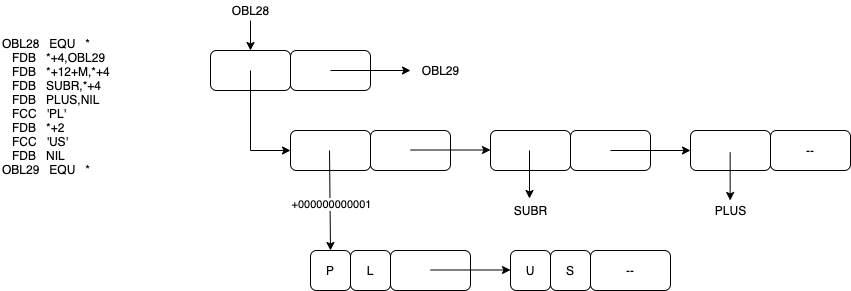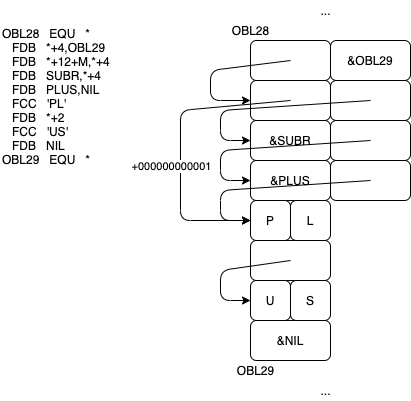PLUS Atom Lisp
Introduction
We examine the ATOM structure in Frits van der Wateren Lisp 1.5. Motorola 8-bit CPU, MC6800.
The code snippet is listed below.
Cell Diagram for PLUS Atom

FDB means initialize double bytes (addresses).
FCC means initialize single bytes.
Memory Layout for PLUS Atom

Comments
Strings Are Tokenized
At the low-levels, this Lisp does not deal with strings.
This Lisp deals only with 4-byte cells, which have been chosen to fit the 8-bit CPU.
In this 8-bit CPU, an address is 16 bits, which is 2 bytes.
CAR is 16 bits (2 bytes).
CDR is 16 bits (2 bytes).
A CONS cell is 32 bits (4 bytes) - one CAR and one CDR.
Magic Marker
Addresses are all mod(4).
Hence, the bottom 2 bits are “free”.
The Magic Marker, called “M”, is set to 000000001 in the address to signify a print-name.
Assembler Directives
The assembler program converts human-readable mnemonics into binary form.
The assembler is line-oriented, i.e. one statement per line.
The assembler assumes that all addresses/offset are byte-oriented.
Addresses/offsets are integers in the range 0-65535.
Labels begin in column 1, all other statements begin after column 1.
The assembler makes 2 passes over the code:
- Determine the location of all labels
- Convert mnemonics into binary.
*
* here - denotes the current binary offset of the beginning of the line.
‘*’ in column 1 creates a comment (to end of line).
The assembler uses a small set of directives that emit no binary.
EQU
The EQU directive equates a label to a value.
Usually, the value is *, in which case the directive sets the value of the label to the current location of the line in the binary.
Example: OBL28 EQU * means to set the label OBL28 to be the offset of the current line.
Example: *+4 means the offset of here plus 4
FDB
FDB initializes “double” words, i.e. 2 bytes.
FDB uses comma-separated arguments and created 2 bytes for each given argument.
Example: FDB *+4,OBL29 means to initialize 4 continguous bytes. 2 bytes hold here plus 4, the next two bytes are initialized to the integer offset of OBL29.
FCC
FCC initializes single bytes.
Strings of byte-sized characters (ASCII) are surrounded by single quotes.
Example: FCC 'PL' means to initialize 2 bytes, the first to the ASCII value of P (0x50 hex, or 80 decimal) and the second byte is initialized to the ASCII value of L (0x4C hex, or 76 decimal).
Code
Frits van der Wateren Lisp 1.5
Code Snippet For PLUS ATOM
OBL28 EQU *
FDB *+4,OBL29
FDB *+12+M,*+4
FDB SUBR,*+4
FDB PLUS,NIL
FCC 'PL'
FDB *+2
FCC 'US'
FDB NIL
OBL29 EQU *